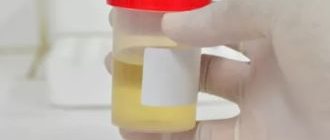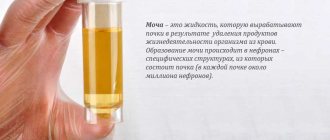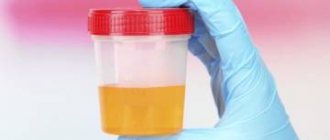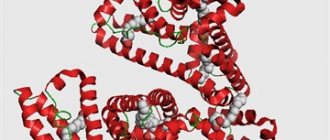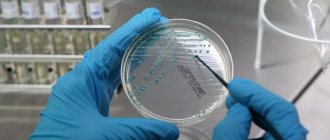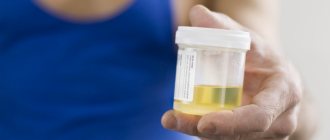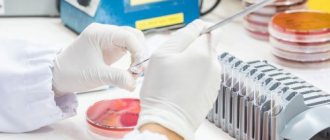A urine sample using the Nechiporenko method is a highly informative addition to a general urine test. The study is carried out as prescribed by a doctor. The main objects of laboratory examination are formed bodies, including: leukocytes, erythrocytes and cylinders contained in biological fluid (urine).
The norm for urine analysis according to Nechiporenko in children over one year of age and in adults is identical. Indicators of the concentration of formed cells in infants may be slightly underestimated, but this is not a pathology. The peculiarity of the sample is that the conditions for collecting urine are observed.
Following all medical recommendations ensures the most reliable result. The study of children's urine according to Nechiporenko is prescribed, first of all, if the results of a general urine test performed earlier are unsatisfactory.
Other indications are the presence of chronic diseases of the kidneys and organs of the genitourinary system, monitoring of therapy for urological diseases. The test is also indicated for symptomatic complaints (of the child or parents) of blood discharge from the urethra, pain in the lower abdomen, frequent urination, etc.
Important! If the pediatrician considers it necessary to check the baby’s urine through a special test, the referral for analysis cannot be ignored. Timely diagnosis is the basis for proper treatment.
Carrying out a urine test using the Nechiporenko method
To obtain undistorted data, proper preparation for the examination and competent collection of material are required.
Preparing the child for the test.
It is necessary to adhere to several rules when preparing a child for the collection of biomaterial, which will ensure the most accurate research indicators
- a sterile container (jar) for collecting urine must be purchased in advance at the pharmacy;
- before collecting samples (1-2 days before), it is not recommended to give the child foods that contain dyes and drugs that have a diuretic effect;
- the child must consume enough water;
- avoid psychophysical overload;
- Teenage girls should not get tested during their period. Blood can get into the biomaterial;
- It is not allowed to collect biomaterial during the treatment of acute infectious lesions.
Rules for collecting urine for analysis
How to give urine according to Nechiporenko to a child? The collection algorithm is as follows:
- biomaterial should be collected early in the morning (6-7 hours), after the child wakes up, before eating;
- Before the procedure, mandatory hygiene procedures are required - it is necessary to wash the genitals. For girls, rinse not only the labia, but also the anus area;
- urine is divided into 3 portions. Parts 1 and 3 are skipped, and the average portion of urine is collected in a jar (normal urine = volume 40-50 ml). To collect the required part, it is necessary for the child to urinate a little first and only then begin collecting;
- The resulting material must be submitted to the laboratory within 2 hours.
Features of urine collection in infants
You can induce urination in the baby by lightly stroking his back along the spine. Infants collect urine in the morning (not earlier than 5:30). The newborn should be washed and not placed on the breast until the material is collected.
An average portion of urine is required, so you need to wait until the child urinates a little and substitute a sterile container. We must not allow the last portion to fall into the jar.
To properly collect biomaterial from newborns, you can use a urine receiver. It is a pouch with adhesive lines that are safe for sensitive baby skin. It can be easily attached and removed.
These containers can be universal or made separately for girls and boys. Before gluing it, the baby is washed and dried with a towel. Then you need to wait until the child begins to urinate, after removing the first portion, glue the urine receiver, avoiding the anus area. The corner of the bag is cut off and the contents are poured into a pre-prepared jar.
Analysis procedure
Advantages of this method
- no expensive equipment required;
- easy to implement;
- no lengthy preparation for the examination is required;
- a large volume of biomaterial is not needed.
The urine is mixed and a certain part is separated into a special container. The laboratory assistant places the vessel in a centrifuge, where it rotates for about 3 minutes. After this, urinary sediment falls into the container, which is examined. It is placed in a special chamber where the number of blood cells is counted. The counted number is then multiplied by a factor to determine their average.
Decoding the analysis results
When studying urine using the Nechiporenko method, the total number is calculated and the ratio of elements in the urine is assessed: “transport” erythrocytes, defenders of the immune system - leukocytes. The presence of hyaline structures is revealed, the appearance of which signals the development of pathoprocesses in the renal system.
Exceeding any of the groups indicates certain violations. Urine analysis in children is deciphered by a specialist who can correctly interpret each value, determine the disease, and prescribe additional examinations.
What to do if there are deviations
Important! Only a doctor can correctly decipher test results and identify the development of pathologies.
To clarify the diagnosis, additional examinations and tests may be prescribed. Among them:
- repeat test according to Nechiporenko;
- urine culture (test for the detection and identification of microorganisms);
- Ultrasound of the kidneys and other organs of the urinary system;
- tomography.
The Nechiporenko urine test is a technically simple and accessible way to identify various pathologies of the urinary system. To obtain correct results, the procedure must be performed in strict accordance with the rules.
How to collect urine from a child
For young parents, the need to collect urine often causes panic, since collecting material for research from a child can be quite difficult.
On the eve of the test, the child must be given a sufficient amount of fluid to drink, which will guarantee that he will urinate in the morning. The baby's genitals are washed thoroughly under running warm water. There are several options for collecting analysis:
- A urinal is attached externally around the genitals and material is collected into it;
- the child is placed on a flat surface, and a previously prepared container is placed under the stream;
- The child is picked up in the bathroom and urine is collected when urinating.
To conduct research, it is enough to take 20-35 ml of urine. The following can lead to unreliability of the resulting analysis:
- non-compliance with the rules for taking fluids;
- collection of urine for diaper rash on the child’s body;
- the baby’s tendency to allergic reactions and their intensification on the eve of urine collection;
- prolonged abstinence of the child from urination.
To enhance natural urges, you can turn on the water in the tap or make appropriate sounds. Children under 1 year of age are recommended to be stroked on the back along the spine. If all urine was collected for research, the pediatrician must be notified about this.
How to prepare for analysis
The test result may be influenced by factors such as antibiotics and certain foods. Therefore, before the analysis, you should follow a special diet for several days: exclude from your diet foods containing dyes, carbonated drinks, sweets and stop using medications.
The first morning urine is used for testing. Before collecting it in a sterile container, the child must be washed with water without soap or other hygiene products. It is necessary to collect a medium portion of urine.
If the test is prescribed for a newborn or infant, parents can collect urine using a urine collector. The urine bag should be secured around the child's genitals and await urination. In this case, it is necessary to warn the laboratory employee that the entire portion has been collected.
You can also place the infant on a diaper and stimulate reflex urination by stroking the abdomen. When the child begins to urinate, you need to substitute a container. Children older than one year are placed on a potty in which a container is placed. The sound of running water can trigger urination.
Collected urine should not be stored longer than 2 hours, as it is a favorable environment for the growth of bacteria.
How to properly collect urine for analysis
Urine should be collected in a special sterilized container. Today, you can purchase special plastic containers at the pharmacy for a small amount. Any glass container of small volume, previously washed and sterilized, can be suitable for this.
The first morning urine is collected. The first portion should be released, only the average urination is taken. Before taking, be sure to thoroughly wash your genitals without using soap. Antibacterial agents should not be used for washing. Getting even a small amount of an antibacterial agent into a liquid is detrimental to bacteria and microorganisms, which will lead to unreliable laboratory tests.
Within two hours, urine must be delivered for laboratory testing. After this time, bacteria will begin to develop in the urine and the results may be skewed. At room temperature, intensive growth of bacteria begins in urine, so initial storage of the material in the refrigerator at a temperature of +4 C is permissible, but not more than 1.5 hours. When delivering urine during a cold period, the sample must not be allowed to freeze, as this will cause cell destruction and may distort the clinical picture.
Preparing for urine collection
Before collecting urine for general analysis, it is necessary to properly prepare the child for this procedure.
Hygiene procedures are important. The objectivity of the study directly depends on the correctness and thoroughness of washing the child.
Poorly performed toileting of the baby's external genitalia can cause the detection of opportunistic microflora and blood cells in the urine.
When talking about how to collect urine from a baby or a newborn girl, doctors pay attention to the following points:
- Wash your hands thoroughly with soap first.
- Place the baby on his back on your forearm, grasping the baby's bottom in the area of the inguinal fold with your palm.
- Place the child's genitals under running warm water.
- Wash the labia minora and majora from front to back.
- When washing, it is better not to use hygiene products (soap, gels), as there is a risk of traces of it getting into the urine sample.
What is needed to collect urine from a baby?
To simplify the urine collection procedure and maintain sterility, doctors advise using disposable sterile urine bags. They are a simple polyethylene tank, the outer opening of which is covered with hypoallergenic adhesive tape. After removing the protective layer, it can be used to firmly secure the urinal to the girl’s genitals.
After obtaining a urine sample for further transportation, it is poured into a special sterile container for collecting urine. In this form, the urine is delivered to the laboratory. If you do not have a special container at hand, the urine can be poured into a pre-washed and treated small glass container. Before this, it must be sterilized in a steam bath.
When is the best time to collect urine from a baby?
To obtain an objective, reliable result of the study, parents need to know when to collect urine from their infant for analysis. Morning urine is always used for research, so the collection procedure should be carried out immediately after the baby wakes up. During the day, the composition of urine changes; daily fluctuations in composition occur due to changes in the phases of the child’s activity.
In addition to collection time, you must consider:
- Delivery time to the laboratory
- after collection, urine should be received for analysis within 3 hours. - Storage conditions
- after collecting urine until transportation, it is better to store the sample of material on the refrigerator door (in a cool, dark place).
How much urine should be collected from a baby?
At the time of issuing a referral for testing, the pediatrician immediately tells the parents how much urine needs to be collected from the baby. In most cases, 20–30 ml of morning urine is needed to conduct a general analysis. However, other types of analysis may require a larger volume of urine, so it would be useful to clarify this point with your pediatrician, if he has not previously indicated.
Normal indicators in children during Nechiporenko analysis
Normal values for urine analysis in children according to Nechiporenko (in sediment):
| Elements | Norm criteria for 1 ml |
| Red blood cell indicators | no more than 1000 |
| Leukocyte values | up to 2000 |
| Indicators of hyaline structures | no higher than 20 |
| Other types of casts (granular, epithelial, waxy, erythrocyte) | not observed |
| Ratio of elements leukocytes erythrocytes | 2/1 |
Normal red blood cell counts
“Transport” cells are the most numerous of the blood structures that circulate through the vascular bed. The “transport” elements contain hemoglobin, which is involved in oxygen saturation of systems and organs. The standard values for this group of elements are up to 1000. The erythrocyte level indicators are the same for any age group.
Normal white blood cell counts
Leukocytes (white cells) play a major role in strengthening defenses against internal and external pathogens. More than 2000 “protective” elements should not be found in the urinary sediment. If the leukocyte level is higher, the condition signals the penetration of infection.
Normal cylinder performance
Hyaline structures are special elements in urine, the appearance of which in sediment indicates the development of pathoprocesses in the urinary system. Acceptable values are no more than 20.
Reasons for deviations
- An excessive number of red blood cells in the Nechiporenko test indicates kidney damage, as a result of which blood cells enter the urine. Such damage may be glomerulonephritis, as well as nephritis caused by toxic damage. An increase in red blood cells also occurs with stones, tuberculosis and tumor processes in the urinary tract and kidneys.
- An excess of leukocytes as a result of the analysis indicates the presence of inflammation of an infectious nature. The child may have pyelonephritis or cystitis.
- A large number of cylinders is characteristic of both infectious inflammation (pyelonephritis) and damage to the renal parenchyma.
Preparing for analysis
For research, according to Nechiporenko’s method, it is customary to prepare an average portion of urine excreted in the morning, immediately after waking up. The first portion of urine is flushed down the toilet within 2 seconds, after which about 20 ml is collected into a container, and the remainder is flushed down the toilet again. To obtain the most reliable analysis indicators, you must follow simple but mandatory rules. Here they are:
- A container for the urine sample is first prepared. It is best to use a plastic container with measuring marks, purchased from a pharmacy. For an infant, you need to purchase a special bag - a urine bag. It fits on the baby like shorts and is secured with Velcro. After urine is released, it is carefully removed, at least 10 ml of liquid is poured into a container and sent to the laboratory;
- Before collecting the sample, the child must be thoroughly washed. This must be done to prevent foreign cells and microorganisms from entering the sample, which are always present in large quantities on the tissues of the external genitalia. Soap and other detergents should not be used, since their residues on the skin can accidentally be washed off along with urine into the sample and greatly distort the results of the study;
- For children of a smart age, you need to give instructions - explain to them that when filling a glass, you cannot touch its inner walls and neck with your hands, and after filling, it must be closed immediately;
- Urine collected for research should reach the laboratory no more than two hours after collection, otherwise its physicochemical parameters may change significantly, and the microflora contained in it will begin to actively multiply, and this will lead to distorted results and require re-analysis.
In addition to the basic rules, there are some points that can also affect the reliability of the results of the Nechiporenko analysis. Not worth it:
- Take a urine test while taking antibiotics;
- On the eve of the test, eat foods that color the urine - beets, blackberries, carrots and others;
- Take vitamin “B” and any other medications that contain actively coloring pigments. These drugs include most artificially synthesized drugs;
- Get tested for girls during their periods. Blood that accidentally enters the test from the vagina can lead to incorrect interpretation of its results.
When is the test ordered?
As soon as the doctor has indicators of a routine urine analysis that has abnormalities in the direction of increasing one or a number of components at once, in order to clarify the characteristics of these abnormalities, urine collection is prescribed for examination according to Nechiporenko.
Using this method of examination, it is possible to identify certain pathological changes that can begin in the child’s body:
- Inflammation in the organs of the ureteral system - the bladder, kidneys, urinary tract.
- Open bleeding from the above structures. Particular importance is given to which red blood cells are identified under the microscope - fresh or already leached.
Patients should be tested a second time so that a specialist can study the dynamics of the disease and clarify the effectiveness of the prescribed treatment course.
Unfortunately, from one such study the doctor is not able to determine a reliable diagnosis, because it requires data obtained in the process of interviewing the patient and carefully examining him. In addition, other procedures are required that are laboratory and instrumental in nature. These include ultrasound, x-ray, bacterial culture.
What does urine analysis according to Nechiporenko show?
Urinalysis according to Nechiporenko can show something that is not visible in a general analysis or that there is even the slightest suspicion of one of the diseases. The doctor looks to see if the patient has an excess of the norm in the content of leukocytes, red blood cells, and casts. When the results are confirmed, it means that there is an inflammatory process, whether it comes from the kidneys or urinary canals.
- Leukocytes. Leukocytes are understood as special substances that fight infection cells. If their number is higher than normal, then this indicates that the source of infection is in the above-mentioned organs.
- Red blood cells. With the help of red blood cells, oxygen is supplied to all organs; if the urine is oversaturated with these elements, then this also indicates a serious inflammatory process.
- Cylinders. The presence of more than normal cylinders indicates that an inflammatory process on the part of the kidneys is occurring in the body at a special stage of the disease. The bacteria are used to determine whether there is a urinary tract infection.
Diseases indicated by urine test results that are higher than normal:
Inflammatory process of the kidneys (pyelonephritis). Having this disease, the patient may not complain about feeling unwell for a long time, which leads to a chronic result of the problem. This disease is often detected only by examining urine according to Nechiporenko, by the presence of leukocytes. Cystitis disease. It is difficult for the patient to tolerate: pain is felt during urination, a constant feeling of discomfort, frequent urge to urinate. This occurs due to inflammation of the inner mucous membrane of the bladder. Urine acquires a characteristic turbidity with a thick sediment. Blood in the urine with a greenish tint indicates acute glomerulonephritis. The Nechiporenko analysis in this case should show whether there are hemoglobin and erythrocyte casts in the urine. Glomerulonephritis enters the chronic stage if urine analysis using the Nechiporenko method shows waxy casts. This is evidence of an extremely severe inflammatory condition. Presence of kidney stones. The manifestation of this disease is indicated by acute colic of the kidneys, it is painful to urinate, and urine comes out with blood. The study reveals salts, which indicate the presence of stones.
How to properly submit urine for examination according to Nechiporenko:
- In order for the analysis to show the necessary results, collect only morning urine. Before doing this, be sure to toilet your genitals. Release the first 20 ml, and put the next portion into a test container with a tight-fitting lid.
- It is better not to eat sweets or fatty foods since lunch the previous day, and stop taking any medications you are taking.
- During menstruation, it is better to postpone urine collection for this study until after menstruation.
- The results will be ready by the next day, and if you used the services of a paid laboratory, then within a couple of hours.
- Additionally, watch a video with information on how to properly collect urine for processing in the laboratory using this method:
In children
What does a children's urine test according to Nechiporenko show? It is necessary to exclude or detect kidney diseases, problems of the urinary system that are sluggish or hidden, which are very difficult to identify. Just like in adults, urine analysis using the Nechiporenko method is examined using a microscope in order to count the number of the same red blood cells, leukocytes, casts, and bacteria.
In this way, they determine whether the child has problems with the liver (using bilirubin content in the urine), what the situation is with the pancreas (alpha-amylase), and the metabolic process is checked (using enzymes and other substances). The normal content of erythrocytes in a child’s urine is 1 thousand per 1 ml, leukocytes - from 2 to 4 thousand per 1 ml, cylinders no more than 20 thousand per 1 ml.
In pregnant women
It is also very important for pregnant women to monitor changes in their health and condition, so they often go to see a doctor and regularly bring urine for a general test. This is necessary because with the development and growth of the fetus inside, it directly affects the rest of the mother’s organs, putting pressure on them
Sometimes this has a bad effect on the kidneys and then a routine urine test indicates the need for additional research - using the Nechiporenko analysis. This analysis should show what the complications are, whether there is an infection, and at what stage it is.
The results of the analysis, which should show the normal content of essential elements in the blood of pregnant women:
- Cylinders no more than 20 thousand per 1 ml.
- No more than 1 thousand red blood cells per 1 ml.
- Leukocytes – up to 2 thousand per 1 ml.
Results
Urinalysis according to Nechiporenko in children allows you to obtain objective information about the health of the urinary system. The main objects of study are leukocytes, erythrocytes and casts. During the study, their concentration per 1 ml of urine sediment is calculated. The obtained indicators should not exceed standard values:
- leukocytes – 2000;
- red blood cells – 1000;
- hyaline cylinders – 20.
The presence of other types of cylinders is considered abnormal. It is important for laboratory diagnostics to strictly follow the conditions of preliminary preparation and the procedure for collecting urine from a child.
If the rules are not followed, the results will be distorted. The pediatrician who referred for the study deciphers the data obtained. The test results are usually available the next day after the test.
Doctors use our secretions to detect many diseases. So urine is one of the important biological fluids of the human body. It carries a lot of information about the state of the internal environment of the body. Consider the study of a child’s urine. One of the methods used is urine analysis according to Nechiporenko.
Good result of urine test according to Nechiporenko
The Nechiporenko examination is carried out by microscopic diagnosis of urine, which reveals:
- erythrocytes - red blood compounds circulating along the blood vessels;
- leukocytes are white blood compounds, their main role in the body is to fight infectious cells;
- casts are compounds formed due to the pathological penetration of protein bodies into the kidneys.
It is difficult to interpret the indicators of cylindrical formations, which is due to their many varieties and dependence on the acidic properties of urine. The alkaline environment of urine prevents their formation by dissolving
The acidic environment of the liquid promotes their reproduction, which is why it is so important to abstain from foods that affect acidity
The norm of leukocytes in the urine of children does not exceed 2 thousand per milliliter of liquid.
The norm of red blood cells when analyzed using the Nechiporenko method is up to a thousand per milliliter of biomaterial.
Cylindrical formations are proteinaceous, epithelial, leukocyte, erythrocyte adherent residues. Casts occur as a result of increased protein content in the urine, leading to proteinuria. Significant release of cylindrical compounds is cylindrouria. For children, the normal number of cylindrical compounds according to Nechiporenko is 20 units per 1 milliliter of liquid.
The norm of indicators in children does not differ from the norm of such organic compounds in an adult.
Advantages and disadvantages of the technique
Based on a more detailed diagnosis, the doctor assesses the adequacy of treatment for the disease; the data obtained help him adjust the treatment process in the absence of positive dynamics. The Nechiporenko test has a number of advantages:
- simple execution mechanism;
- convenience and accessibility;
- a small volume of urine is sufficient for testing;
- information content;
- unification.
The disadvantages of the technique include the lack of daily monitoring when analyzing the study. If necessary, such an analysis is provided separately. Using the data obtained, the doctor can obtain laboratory confirmation of unexpressed leukocyturia accompanying chronic or sluggish glomerulonephritis. In diagnosing renal diseases, an increased number of red blood cells confirms the development of atherosclerosis, glomerulonephritis. In the case of high values of leukocytes, a diagnosis of pyelonephritis is indicated. At the same time, the calculous form of the pathology is accompanied by the appearance of red blood cells in the urine sediment.
The Nechiporenko test helps to identify abnormalities in the composition of urine in a child without age restrictions. It is prescribed as an additional research method if abnormalities in the functioning of the excretory organs are suspected. But it is impossible to make a diagnosis based solely on data, as the analysis shows. Diagnostic measures and a treatment regimen are prescribed by the doctor depending on the results obtained.
Traditional decoding of analysis indicators
Each element identified in urine when examined using the Nechiporenko method can indicate a certain type of problem.
An increase in the number of leukocytes is characteristic of cystitis, prostatitis, urolithiasis, pyelonephritis and kidney infarction. In such diseases, their level often exceeds 2000 units per 1 ml of fluid.
With such pathologies, 1000 or more red blood cells are detected in 1 ml of urine tested quite often.
Cylinders. Detection of 20 or more hyaline casts per 1 ml of urine, as well as any detectable amount of their other types, most likely indicates kidney dysfunction. This condition corresponds to glomerulonephritis, from acute to chronic, hypertension and pyelonephritis.
Detection of hyaline casts in urine above normal levels may be the result of active use of diuretic medications.
Granular casts in the urine of healthy children; the norm is their complete absence. Such formations appear in the process of massive death of the mucosal cells of the inner walls of the kidney tubules. A large amount of them in the urine is accompanied by symptoms of pyelonephritis, glomerulonephritis, infection with pathogenic microorganisms and poisoning with lead compounds.
Waxy casts are a sure sign of a pathological condition of the body. They are detected in the urine of children affected by renal amyloidosis, renal dysfunction, and nephrotic syndromes.
Red blood cell casts appear during the massive release of red blood cells into the renal tubules through damaged blood vessel walls. As they accumulate, they lead to blockage, resulting in the appearance of cylindrical bodies of this type. It is clear that this phenomenon has nothing to do with the norm, and often results from conditions - thrombosis of the terminal veins, renal infarction, acute glomerulonephritis or hypertension with a malignant course.
Epithelial casts are the result of detachment of epithelial cells of the renal tubule. Their appearance in the urine, in any quantity, is a sign of dangerous pathological conditions. This may be severe toxicosis due to poisoning with salicylates, heavy metal salts, nephrotoxins, for example, phenol or ethylene glycol. Acute conditions of viral infection and necrosis of renal tubules also lead to a significant release of casts of this type into the urine.
Video on the topic
Clinical significance
This method of research makes it possible to detect unexpressed leukocyturia, which is often observed with gloerulonephritis of a chronic, latent or sluggish form and cannot be detected by picroscopy of sediments.
The method is used in diagnosing kidney diseases. Elevated red blood cells confirm the development of arteriosclerosis or glomerulonephritis, an increase in leukocytes is inherent in pyelonephritis. It should be remembered that calculous pyelonephritis is confirmed by red blood cells found in sediments.
Numerous studies using Nechiporenko’s method make it possible to confidently state that this method is very adequate when prescribing a therapeutic course and helps to correct the treatment process.
During medical examination, the technique will help to track the progress of the disease and immediately prescribe additional medications if deviations from the norm are detected.
